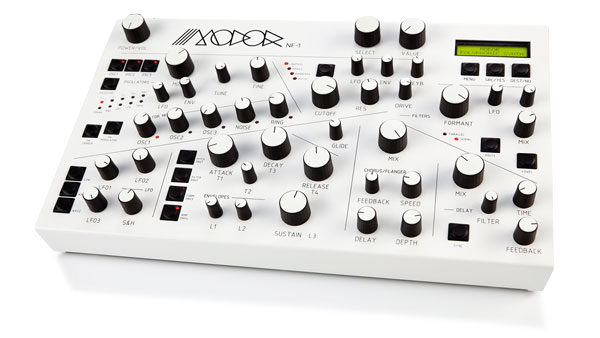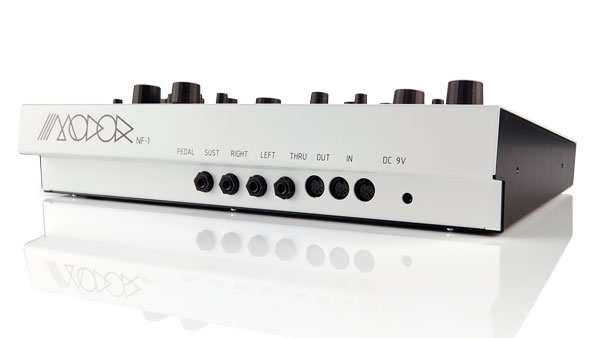MusicRadar Verdict
The NF-1 is well-built and hands-on and its sound engine is powerful and versatile.
Pros
- +
It's well built and the hands-on interface really inspires creative sound design. There's plenty in the way of sound-shaping onboard and some nicely unorthodox options are available. It has a chameleon-like character and covers a surprising amount of sonic territory.
Cons
- -
Quite expensive.
MusicRadar's got your back

Modor NF-1

Rear
Belgian company Modor Music is one of the newest synth manufacturers on the scene and it's always exciting to try brand new products from a brand new company. We hadn't heard much about Modor or its NF-1 synth until recently but as soon as we laid eyes on it we knew it wasn't going to be your average synth!
Over the past months we've seen renderings and prototype photos and often these days many products remain as 'vapourware'. However, we're happy to report the NF-1 has firmly left the drawing board and is now in production.
The NF-1 arrived in a brown shoebox-style box adorned with Modor's distinctive logo. First impressions are great and the NF-1 is a weighty beast of a module with a large footprint and a sloping profile, off-white-painted steel case.
"This is a hands-on 'what you see is what you get' tweaker's delight and it's been very well thought out"
Also included in the box are two lovely wooden end cheeks for using the NF-1 on your desktop and two rack ears for rackmounting. The front panel has something of an unorthodox layout but it works surprisingly well in practice and the layout really inspires creativity and forces you to think differently.
Everything is laid out in logical sections and there's very little need to go into the menus or look at the screen unless you want to tweak deeper system settings and modulation routings - this is a hands-on 'what you see is what you get' tweaker's delight and it's been very well thought out. So far so good then!
Control-wise, the hard plastic switches feel very similar to those found on Nord keyboards (ie very high quality) and they bottom out with a reassuring click.
The dials are a nice grabbable size and are made of lightweight plastic, though they do have a little play in them. We also think that some weighty Moog-style knobs would be more in keeping with the otherwise solid build.
Round the back there's a pair of jack audio outputs, a sustain pedal input, a volume pedal input and MIDI In, Out and Thru (DIN) connectors, though a USB port is conspicuously absent for a new synth.
Any OS updates are thus done over the standard MIDI jacks via SysEX which is obviously more clunky than using a single USB cable to your DAW.
Finally, there's a 9V wall-wart connector (a built-in power supply would have been nicer) and there's also no clasp to hold the power lead in, so the wire can be easily pulled out. Maybe these things could be improved in the future.
Digital and proud
Now let's take a look at the NF-1's expansive sound engine. This is a firmly digital synth - in fact the explanatory booklet that comes with the NF-1 proudly proclaims "yes it's digital and we're proud of it".
We like the fact that this synth isn't obviously trying to be analogue for a change (except for the dial-per-function ethos) though coincidentally, it can be very analogue sounding at times as there's plenty of tangible texture to the overall sonics.
It has 448 user-writable memories and it's a three oscillator, mono-timbral, eight-note polyphonic design. Each oscillator has ten waveforms available including saw, square and triangle, plus a sync osc, Additive Harmonics, Sonar Noise, Wind Noise, Arcade Noise, FM and Sinus Feedback FM.
Also, each of the waves has a specific modulatable parameter associated with it in addition to the mod matrix routings. So for example, the saw, square and triangle all have PWM, the sync osc has a frequency parameter and the additive harmonics wave has a 'harmonic separation parameter'.
These parameters can be modulated manually by the MOD dial, by one of three LFOs (two have switchable waveforms), or via an envelope using the LFO/ENV dials (found in each section).
When no osc is selected, the oscillator LFO and ENV dials act as pitch mod controls and generally it's easy to dial in just the tone that you want at basic wave level.
Note that LFO1 (hardwired to the oscillators) goes into the audio range, whilst LFO2 (hardwired to the filter) is MIDI- syncable. LFO3 (triangle) is hardwired to the mod wheel, though importantly each LFO can be sent to other mod destinations too (59 destinations and 16 sources) via the seven modulation 'wires'.
"It's a well thought out and powerful design that has its own unique and ultimately very inspiring sound"
Once you have chosen your oscillator waves for the three oscs, you have a handy volume mixer for all three oscs, plus ring mod and white noise can be added here too. What we really like is that each oscillator has a select button/ LED so you can edit one, two or all three oscs simultaneously using a single set of controls.
Once your oscillators are set, there are plenty of sound-shaping parameters to work with including four envelopes. Each envelope has hardwired destinations (Env1 to Osc1 Mod/ Pitch, Env2 to Osc2 Mod/Filter, Env3 to Osc3 Mod/Formant and Env4 to Amp) but they can also be sent to other modulation destinations via the aforementioned modulation 'wires' so there's plenty to take a basic three- oscillator sound into outer space!
Complex sounds
Each envelope can act as a familiar ADSR but there are additional controls for controlling the level of each stage (and the time it takes to move between each stage) which gives you plenty of flexibility for creating complex evolving and looping-type sounds.
The envelopes are nicely punchy too for making snappy basses and punchy percussion sounds and bleeps and the NF-1's envelope set-up is quite similar to the set-up on the Alesis Andromeda - similarly some aspects of the NF-1's envelopes are initially confusing but after some playing about you'll get the hang of it! (For a basic ADSR, set L1 and L2 at max and T2 at zero and use the ADSR controls as normal.)
Like the oscillator section, if all four env select lights are on, the single set of envelope dials control all four envelopes simultaneously making it easy to dial in radical real-time changes.
Couple all this with the multimode filter and separately mixable formant filter and the delay and comb filter/ chorus/flanger FX sections (plus filter drive), and you can see that this isn't some 'flash in the pan' synth. It's a well thought out and powerful design that has its own unique and ultimately very inspiring sound.
Notably, for a new synth it's solid OS-wise and feature-wise it's well specified, though it currently misses a mono/legato mode and an arpeggiator/sequencer (though sending an LFO to an additive harmonics osc and messing with the harmonic spacing can yield arpeggiator-like results).
Sonically the NF-1 can be upfront or ambient in character and we love its overall vibe and sound - it can happily make grungy, lo-fi and metallic noises/ sounds but within a few dial tweaks you'll stumble upon nicely warm pads, glistening FM bells/organs/pianos, round or nasal basses, talking sounds (using the formant filter), wide analogue-sounding strings and sawtooth brass patches, surprisingly deep subs (for a 12dB per octave filter machine), ambient evolving textures, out-there FX and more.
It is one of the most inspiring synths we've tried in a while and it will definitely appeal to studio-based sound designers/producers and live tweakers looking for something that breaks the mould in terms of layout and sound. Virtually every parameter onboard can be addressed/sent over MIDI too.
To conclude, it's not cheap but it's a nicely different sounding/looking synth and it deserves your attention. If you're looking for a synth that's very hands-on and that inspires unique new sounds and ideas quickly, the NF-1 is killer!
With its latest free update, Ableton has finally turned Note into the app I always wanted it to be
Technically capable, but struggle to make your tunes sound musical? 5 simple music theory hacks to make your tracks stand out
"Despite its size, it delivers impressive audio quality and premium functions as well as featuring a good selection of inspired sounds": Roland GO:Piano 88PX review









